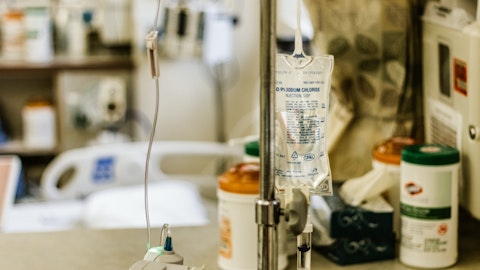Jack Meehan : Okay. And then I appreciate all the comments on the China VBP. I was just curious if you could clarify, do you plan to participate in this program at all? And do you think in future test categories? How important is it for you to maybe get exempt from the program?
Douglas Bryant : Yes. So there’s two sides to this, you’ve had other VBPs that have included clinical chemistry, and some of those excluded our products because their drive life chemistry. And one, a couple of years ago, I don’t have all the details in front of me, but we chose to participate. We did reduce price we actually increased volume pretty dramatically. I think my colleagues in the diagnostic industry look at it the same, while it is a threat to price, sometimes it gives you greater access to the volume that’s out there that we might not ordinarily have had access so easily. So in that case, two years ago, Ortho actually was the winner and did pick up the volume. So we will try to participate in this tender, but it really is only hormones, infectious disease tests and HCG, which are pretty low volumes for us.
If we do choose to participate, we will more than likely reduce our pricing as was done in 2021 about that same level, pretty Draconian, but it could be valuable to us in order to retain our volume. That’s the case. You heard me in my prepared remarks say that that’s 0.72% impact if we were to reduce pricing at that level. But that would be the worst case scenario, actually, because you have to remember that we’re going through distribution and distribution will pick up part of that price. So yes, we are going to participate if we can. Of course, we would. That would be the impact if — and if we didn’t pick up any volume, but simply retained what we had.
Jack Meehan : Okay, got it. And just last question, the account — maybe for Joe, the accounts receivable stepped up, I think, $85 million sequentially. What drove that?
Joseph Busky : The higher respiratory revenue in the quarter. And by the way, we — our global DSO Jack, is 33 days, and it’s — I believe it’s 20 or less from the U.S. So all that respiratory revenue overachievement was in the U.S. So we’ve already collected all that cash. So, yes, that’s what drove up, and we’ve got a very, very solid DSO. Yes.
Jack Meehan : Thank you.
Douglas Bryant : Yes, thank you. Thanks, Jack.
Operator: Our next question is from Andrew Cooper with Raymond James. Your line is now open.
Andrew Cooper : Hey, guys, thanks for the questions. Maybe just sticking with the Labs business a little bit. Can you give us a little bit more color just on sort of what the typical seasonality is here and how we should be thinking about one, what that meant for 3Q, but also when we think about that 4Q, I look at it and see a relatively easy comp. We have the backlog of instruments back to normal, which should be a tailwind here. So is there a scenario where this could be faster than the high single digits you pointed to in 4Q? And if not, maybe what might be limiting that relative to some of the tailwinds that we think about in the space.
Joseph Busky : And Andrew, you’re specifically talking about the labs business?
Andrew Cooper : Correct.
Joseph Busky : Or non-respiratory, right?
Douglas Bryant : Yes, it is.
Joseph Busky : Yes, I mean, I do think there, again, we’ve got great visibility into this business.
Douglas Bryant : So let’s just start with the timing part of the question. So coming out of Q3, which is typically the lower in terms of instrument orders. Q4 not only is higher decisions made before May before year-end. But often, if they’re sale instruments, we would see them higher in the fourth quarter. So I’ll start with that. I mean that’s what’s driving some of it. And then the question that Andrew, I think, is really trying to get at is there potential upside there? And I would say, yes, but we have to deliver. We have to execute. And we have to get — we got to get installs. We got to make sure that we’ve got everything covered on the supply chain side, and everything has to go pretty darn well to be a lot better than what we’re forecasting how do you feel about that?
Joseph Busky : I’ll leave it aside, but I’ll comment further on the…
Douglas Bryant : What they’re witnessing it’s just the optimism of the CEO and the conservatism of the CFO.
Joseph Busky : But I will comment further on the seasonality of the last instrument revenue, and I think it’s probably a good point to hammer on. If you look at the five-year average of that legacy Ortho business, Q1 and Q3 are typically the lowest instrument revenue quarters, and the five-year average is about 22% to 24% of the instrument revenue in those quarters. And then Q2 and Q4 are the highest revenue quarters for lab instruments at 26% to 28% percent of the annual instrument revenue. So we will see an uptick sequentially from Q3 to Q4 on lab instrument revenue. Yes, that I can say with a lot of confidence.
Andrew Cooper : Okay. Helpful. And then you mentioned capital deployment and not necessarily doing any buybacks as of yet. As we continue to see the stock price sort of come down, rates remain kind of steady. How do we think about that decision-making process and where that threshold is to get a little bit more aggressive on the buyback as opposed to prioritizing debt paydown as you have so far?
Douglas Bryant : Well, we’ve said before in terms of capital allocation that we look both at debt repayment as well as share repurchase. And when we do the math right now, obviously, the math would tell you that it’s probably better to be buying shares than paying out debt, but it’s not dramatically so. So, but we’ll continue to be opportunistic for sure.
Andrew Cooper : Okay, I will stop there then. Thanks for the question.
Douglas Bryant : Thanks, Andrew.
Operator: Our next question is from John Sourbeer with UBS. Your line is now open.
John Sourbeer : Hi. Thanks for taking the questions. I was wondering if there’s any additional color divide on the Savannah backlog and then maybe more broadly on molecular diagnostics. Just any updates on the shift you’re seeing there from centralized labs to decentralized solutions, and then how should we think about Savannah offsetting this in 2024?



